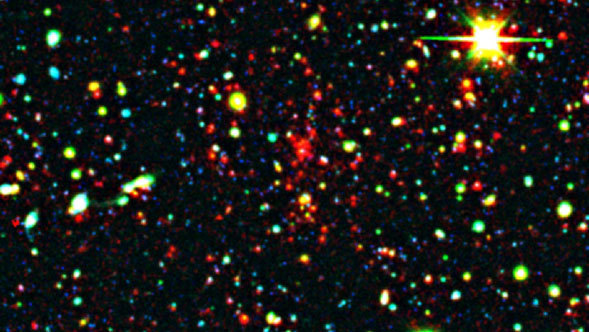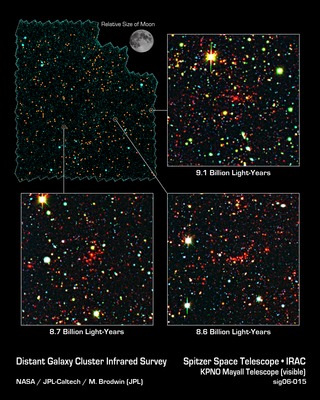
News Release • April 8th, 2008 • feature08-04 •
Written by Linda Vu
Spitzer Science Center
The universe's first "galactic cities" did not sprout up randomly across space. On the contrary, a new statistical analysis of observations from NASA's Spitzer Space Telescope confirms that these ancient galactic metropolises may have developed much like sprawling cities joining together into a larger urban whole.
Across the cosmos, galaxies rarely stand alone. Instead, they are grouped into large, densely populated communities containing thousands of galactic residents, called galaxy clusters.
"Previously, we only knew of a handful of galaxy clusters that existed when our universe was in its first few billion years. Now, thanks to Spitzer's superb sensitivity, we've identified over a hundred," says Dr. Mark Brodwin, of the National Optical Astronomy Observatory, in Tucson, Ariz.
Using Spitzer's substantial sample of distant galaxy clusters, Brodwin and his colleagues were able to conduct a statistical analysis showing that distant galaxy clusters tend to huddle together -- like cosmic urban sprawl with neighborhoods growing together into a larger and larger community.
"The clustering of clusters indicates that these ancient galactic cities are not randomly distributed across space," says Brodwin.
Astronomers have long suspected that the first galaxy clusters grew in very special regions of space, where pockets of hot gas began collecting hundreds of thousands of years after the big bang. The fact that ancient galaxy clusters clump together could be evidence that they formed in such dense regions in the early universe.
Brodwin notes that this observed clumping matches current astronomical theories about galaxy cluster formation. Theory predicted the density of these cosmic cities in the distant past, and the recent measurements of his team have confirmed these predictions.
"This analysis is helping us understand how the largest structures in the universe came to be," says Brodwin.
Brodwin's paper was published in the December 20, 2007 issue of Astrophysical Journal Letters. Co-authors on this paper are Leonidas Moustakas, Peter Eisenhardt, and Daniel Stern, of NASA's Jet Propulsion Laboratory in Pasadena, Calif.; Anthony Gonzalez, of the University of Florida, Gainsville, Fla.; Adam Stanford, of the University of California at Santa Cruz; and Michael Brown of Monash University in Clayton, Australia.





